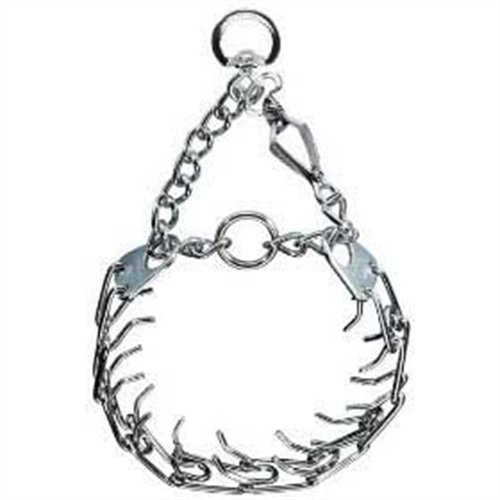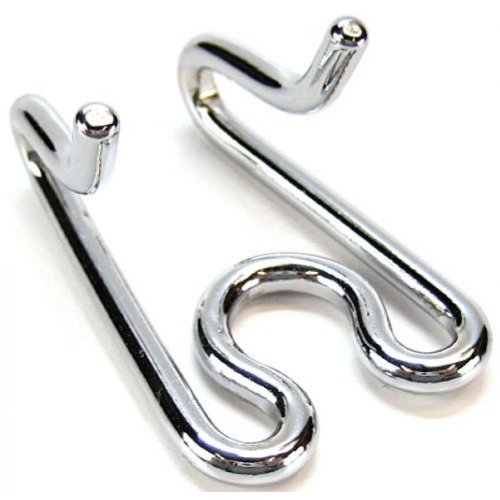
A prong collar looks like a barbaric torture device. In actual fact, though, a prong collar is a safe, humane way to quickly teach your dog to not drag you around with the leash. Fitting a prong collar is different than fitting any other kind of collar; we will briefly describe the process.
If your dog pulls, lunges, or occasionally over-powers you on walks, a prong collar is ideal for you. Unlike most other anti-pulling devices a prong collar feels and acts exactly like a regular collar to the dog as long as the dog behaves itself. The collar only engages when the dog mis-behaves. It's kind of like having emergency brakes on the dog.
A prong collar is a kind of martingale- it tightens when pressure is applied, but it only tightens so much. When properly fitted, a martingale will not cut off your dog's airway like a choker does. Martingales are commonly used to keep dogs from being able to back out of or slip out of a collar- they are pleasantly loose unless the dog pulls and then they tighten just enough. That is exactly how a prong collar works, too.
When the dog pulls on the leash the collar tightens around the dog's neck and the metal prongs engage. Note they actually point sideways, not straight down. What they do is pinch the skin of the dog's neck between them as the collar tightens. They don't dig into the dog's neck or cause severe pain or any physical damage. Dogs have rather insensitive necks- watch them play sometime and see how hard they bite each other's necks. So all the collar does is pinch the skin unpleasantly when the dog pulls. When the dog does not pull, the collar relaxes and feels very comfortable for the dog to wear. You'll never have to "train" your dog to wear a prong collar, and most dogs who walk in them get all excited when they see one because they know it means time for a walk.
Prong collars are not sold by the length like most collars. They are sold by the size of the links. The links come in large, medium, small and micro. Most people think the bigger the dog, the bigger the links, but not so. The smaller the links, the harsher the collar is. Each link pinches skin, and a smaller collar has more links per inch so it pinches more. If you're a horse person, you'll understand the analogy to a bit- a thin bit is harsher than a thick bit.
You might have to do some trial and error- if the dog doesn't seem to really notice the "bite" of the collar you selected, switch to a collar with a smaller link size. Most dogs who are in the 30 to 150 pound range do fine in a medium-sized link (3 mm width). The less sensitive types of dogs, like labs and bully breeds, usually do better in a small link (2.25 mm width). A very sensitive, gentle Great Dane might do best in a large link. The smaller dogs generally need a micro-sized or even a mini-micro sized link. Make sure you get a quick-release type of collar otherwise you will have a lot of trouble getting the collar off and on the dog.
You may see some "prong collar" types for sale that don't have a martingale action, namely they don't tighten at all when the dog pulls. Frankly, we cannot figure out how these collars are supposed to work and suggest avoiding them. The links cannot pinch properly if the collar cannot tighten.
If you don't like the barbaric look, you can buy or make covers that fit over the collar. These are simple pieces of fabric that usually fasten with Velcro over the collar. You can buy them in plain black, or in a wide range of collars, embroidered with your dog's name if you like.
 Pet Supply Imports Herm Sprenger Chrome Plated Training Collar with Quick Release Snap for Dogs, Medium, 3.0mm, 21-Inch
Pet Supply Imports Herm Sprenger Chrome Plated Training Collar with Quick Release Snap for Dogs, Medium, 3.0mm, 21-InchAbsolutely not. A choke chain looks less barbaric than a prong collar, but choke chains are extremely dangerous. Choke chains tighten without limit and choke a dog. When used properly the dog is never allowed to pull into the choker and choke because the owner is hitting the dog with hard collar-pops as a correction whenever the dog steps out of heel position. Using a choker to do collar-pops properly takes a lot of practice. We think people shouldn't bother to learn this skill because corrections delivered by a choker have been shown to cause permanent, painful damage to dog's necks. Even when used by an expert collar-popper, dogs in choke chains always end up with physical damage to their necks, as proven by several autopsy studies. We think that is totally unacceptable. And most casual dog-owners simply don't have the timing and skill to use a choker properly, so their poor dogs end up with collapsed tracheas, damaged vertebrae and severe neck arthritis. Throw your choke chain in the garbage.
Once you have the collar, you'll need to fit it to your dog by adding or removing links. When closed by pulling, the prong part of the collar should fit snugly around the dog's neck without being too tight- just enough to engage the prongs against the skin. The links are added by squeezing the two points together and sliding them into the loops on the next link, or removed by squeezing them together and pulling them out of the loops. You may need to get someone with strong hands to do this for you.
Measure the dog's neck at the top, where it is narrowest. This is the approximate length that the prong part of the collar needs to be. When you buy the collar itself, you may need to buy extra links, particularly if you are buying a small-link prong collar for a 95-pound American bulldog.
 Herm. Sprenger® Prong Collar Extra Links, 3.00 mm
Herm. Sprenger® Prong Collar Extra Links, 3.00 mmOnce you have the prong collar on the dog, simply snap your sturdy 6-foot leash to the live ring of the collar. The live ring can be identified by pulling on it- the collar should tighten when pulled on. Never leave a prong collar on an unattended dog. Never let your dog run free with a prong collar on. Never attach a long line or a retractable leash to a prong collar.
That's it! We don't believe in doing collar corrections and prefer to let the dog do all of the work with the prong collar. If the dog pulls, the prong collar tightens unpleasantly. If the dog doesn't pull, the prong collar is nice and comfortable. Try praising your dog sometimes when the dog is walking nicely to make sure the dog understands he is being good.
 Herm Sprenger Nylon Cover for 2.25 MM Prong Pinch Collar
Herm Sprenger Nylon Cover for 2.25 MM Prong Pinch CollarCopyright © 2005-2016 Pet Information All Rights Reserved
Contact us: www162date@outlook.com